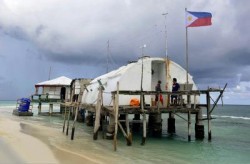ASEAN foreign ministers called for
‘the early conclusion of a Regional Code of Conduct in the South China Sea’ on
20 July 2012.
One fact to be recalled is the downgrading of the initial 2002 document from a legally binding code to a political declaration — the Declaration on the Conduct of Parties in the South China Sea. The question of where a ‘legally binding’ code would apply was the ultimate cause of this downgrade, with the inclusion of the Paracels and the exact location of the nine-dash line found on Chinese maps the main sources of dispute.
Yet a code of conduct continues to be proposed; at the July 2011 ASEAN Ministerial Meeting, the ‘guidelines’ for the declaration’s implementation were adopted, including the approval of a code of conduct.
Is the uncertainty over its area of application still an obstacle to the document’s adoption? If it is, how do the supporters of a code of conduct propose to overcome this problem? Another question hanging over the proposed code of conduct is whether it would be concluded between China and ASEAN as a whole, or between China and individual claimant states. This problem reflects the well-worn debate over bilateralism, China’s preferred option, and multilateralism, which most ASEAN states prefer.
It is true that member states usually enter into ASEAN-related agreements as individual signatories. But this particular declaration was first negotiated among ASEAN officials before they sat down with their Chinese counterparts. The chairman’s statements from both the November 2011 and April 2012 ASEAN Summits also noted that the 2002 declaration had been ‘signed between ASEAN and China’. Moreover, the bulk of sovereignty and jurisdictional issues cannot be resolved through bilateral negotiations alone. Most of the disputes in the Spratlys and other parts of the South China Sea involve more than two parties; only the Paracels seem conducive to bilateral treatment.
Should ASEAN members thus consult among themselves before holding discussions with China on the South China Sea? This matter is for ASEAN, and ASEAN alone, to decide — although it seems that intra-ASEAN discussions on the development of a regional code of conduct have already taken place, and that the results have been given to China as a basis for negotiation.
A related question is at what stage China should be involved in the formulation of a proposed code of conduct. Some in ASEAN think this should occur after ASEAN has reached a consensus; others insist that China should be involved from the beginning. In a certain sense, the issuance of the ASEAN foreign ministers’ statement of 20 July has rendered this a moot point, although it may be presumed that the draft was cleared with the Chinese beforehand.
Timing is another point to consider. The longer the prospect of a code of conduct tantalises those impatiently waiting for it, the more the Chinese and their sympathisers can claim that others, like the US, should stay out of the debate, since negotiations are already taking place. This is probably why the July ASEAN statement called for ‘the early conclusion’ of a code of conduct. But how early is ‘early’?
Perhaps the most fundamental reason why the conflicting claims in the South China Sea are so difficult to resolve is that all the claimants feel their footholds in the South China Sea are essential to their national interest.
China undoubtedly fears that those who try to prevent its rise might use the South China Sea to surround or contain it. At the same time, the Vietnamese no doubt recall that China colonised their country for more than a thousand years, and that China attacked Vietnam at the beginning of 1979, and gained a foothold in the South China Sea by ejecting South Vietnamese troops from their half of the Paracels in 1974 and unified Vietnamese forces from some of the Spratlys in 1988. If Vietnam were now to surrender its claims to the South China Sea, it would be almost completely surrounded by land features and maritime regimes that China claimed as its own.
Filipinos have also not forgotten that Japan invaded their country from the Spratlys, and thus feel the need to push their western frontier as far out as possible. The Philippines’ demand for fish, oil and gas is also strong. The two wings of Malaysia, meanwhile, are linked by a large expanse of the South China Sea. And Brunei Darussalam wants access to the resources lying within and beneath its ‘exclusive fishing zone’ and continental shelf as insurance against the day when its lucrative oil and gas fields run dry.
This clash of national interests underlies the conflicting claims to the South China Sea, and makes compromise very difficult. Equally unhelpful is that policy makers are enjoying shorter tenures and are often influenced by societies that are vulnerable to over-simplified concepts. Hence, the disputes in the South China Sea will not be resolved anytime soon, if at all. The goal must be to prevent the disputes from developing into armed conflict, and this could be the overarching aim of any code of conduct. The document should, at the very least, declare that national interests might be pursued, but not at the expense of other countries.
Rodolfo Severino is Head at the ASEAN Studies Centre, Institute of Southeast Asian Studies, Singapore, and a former ASEAN secretary-general.



No comments:
Post a Comment